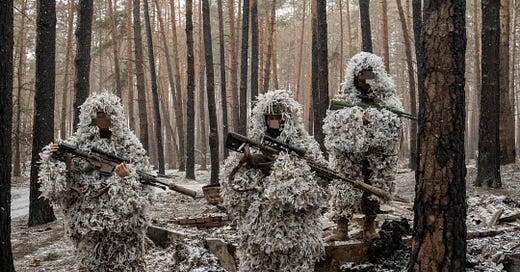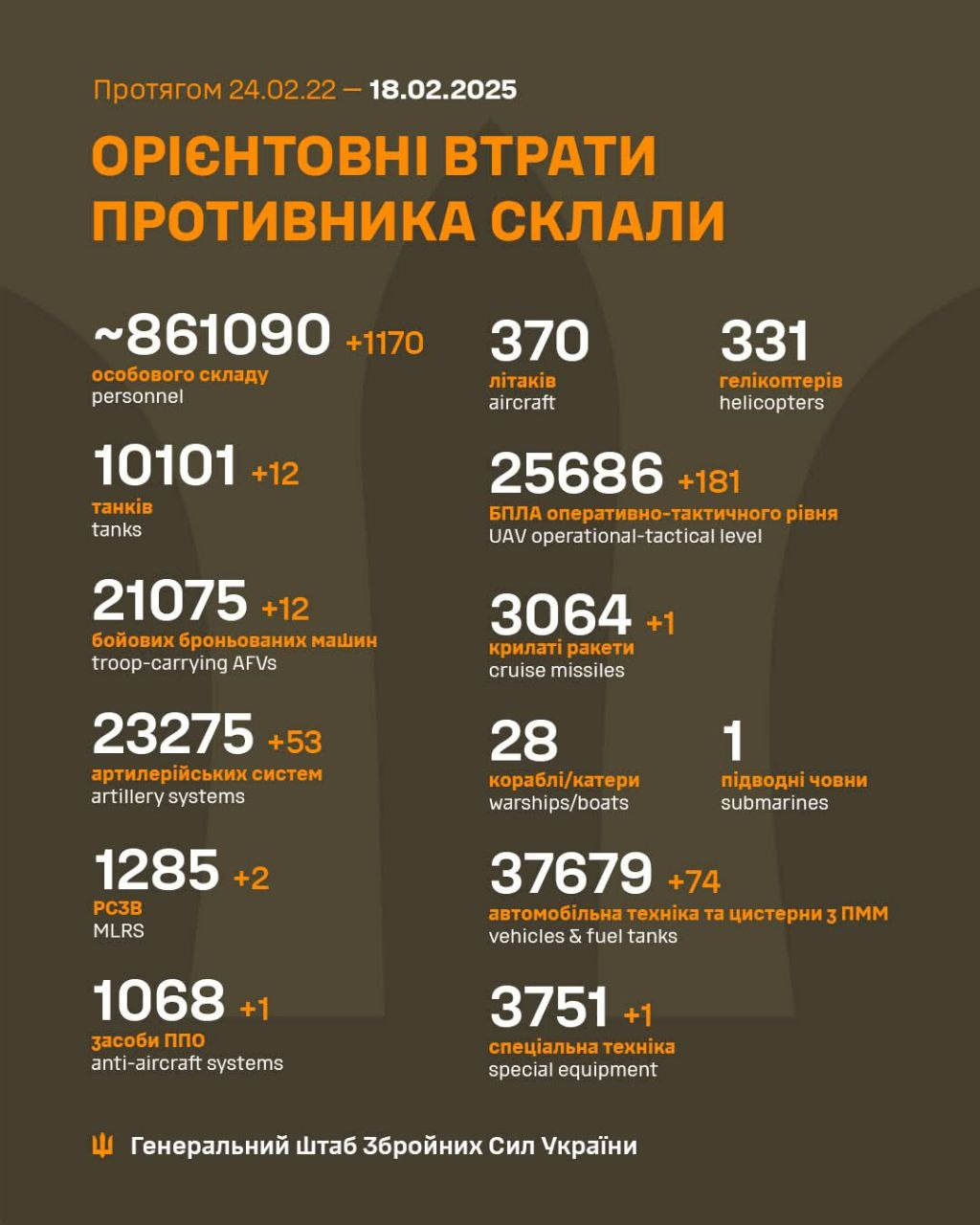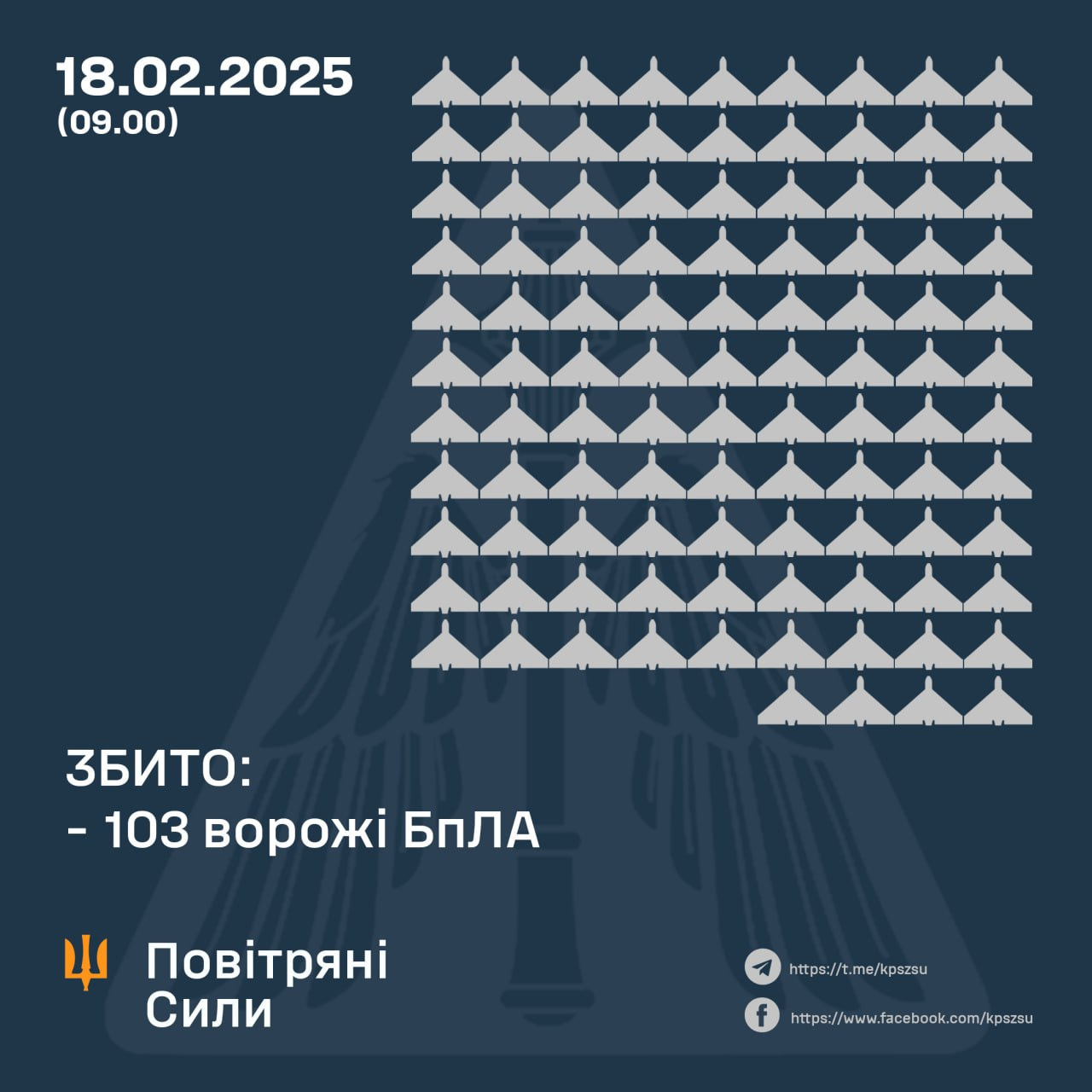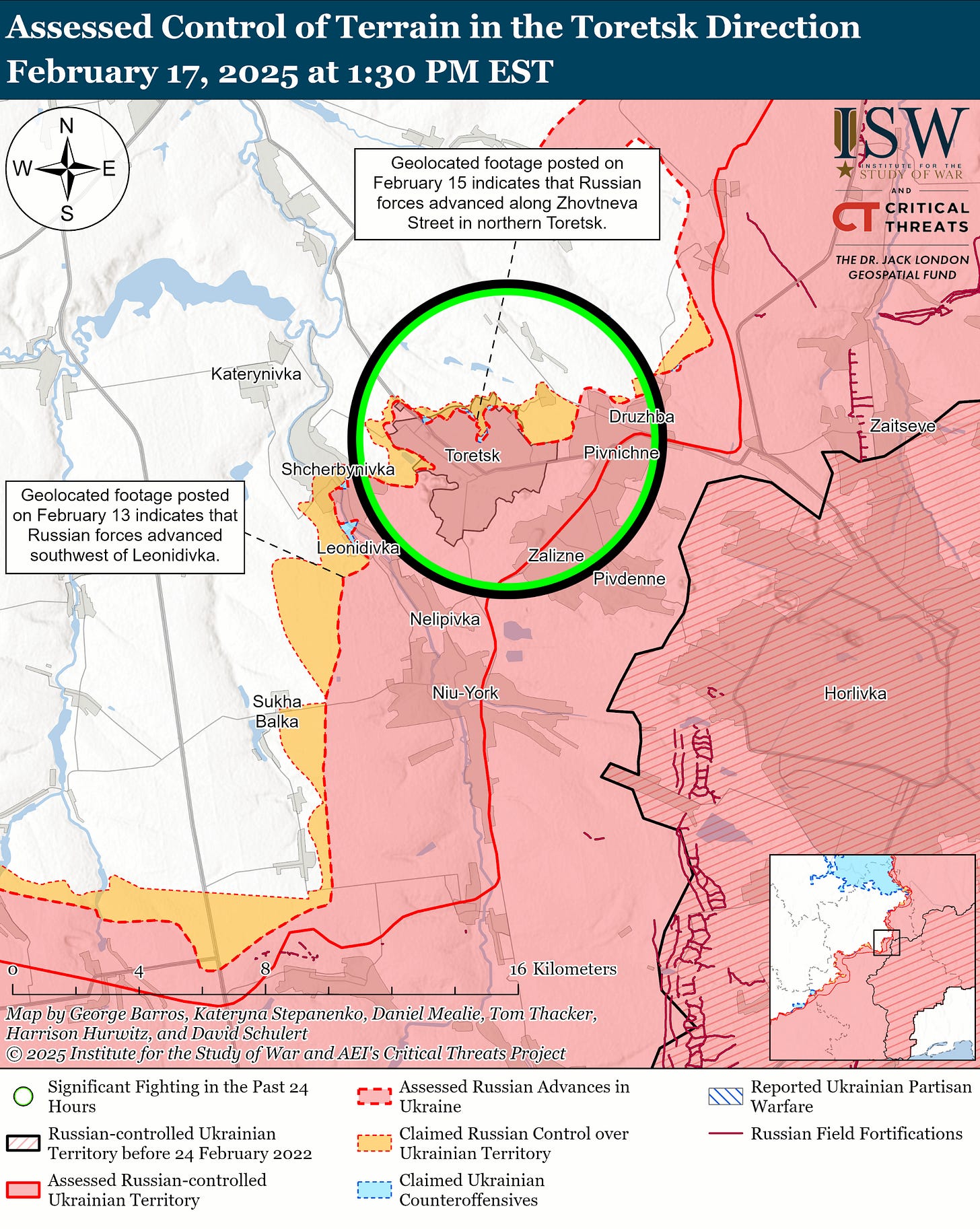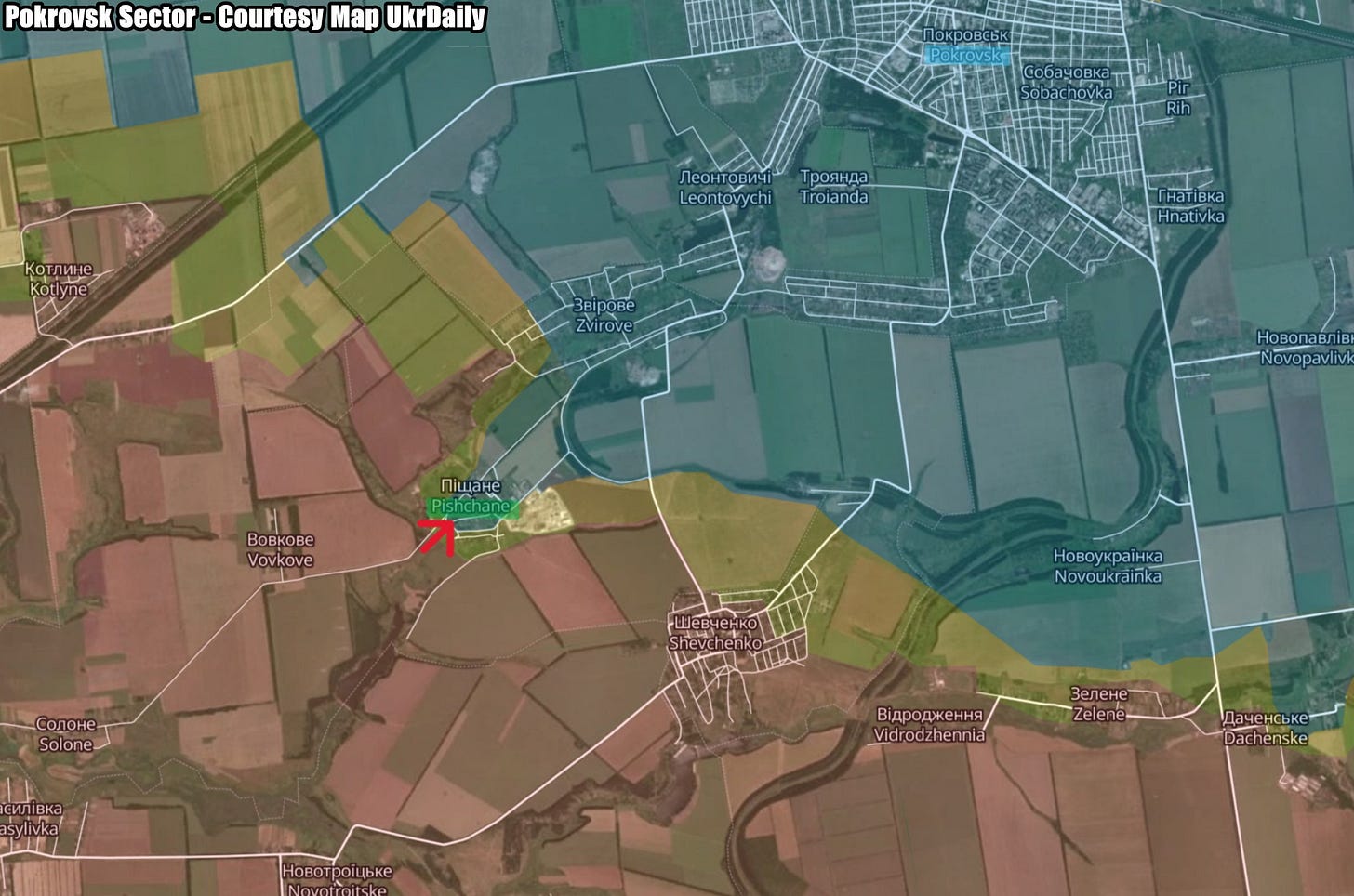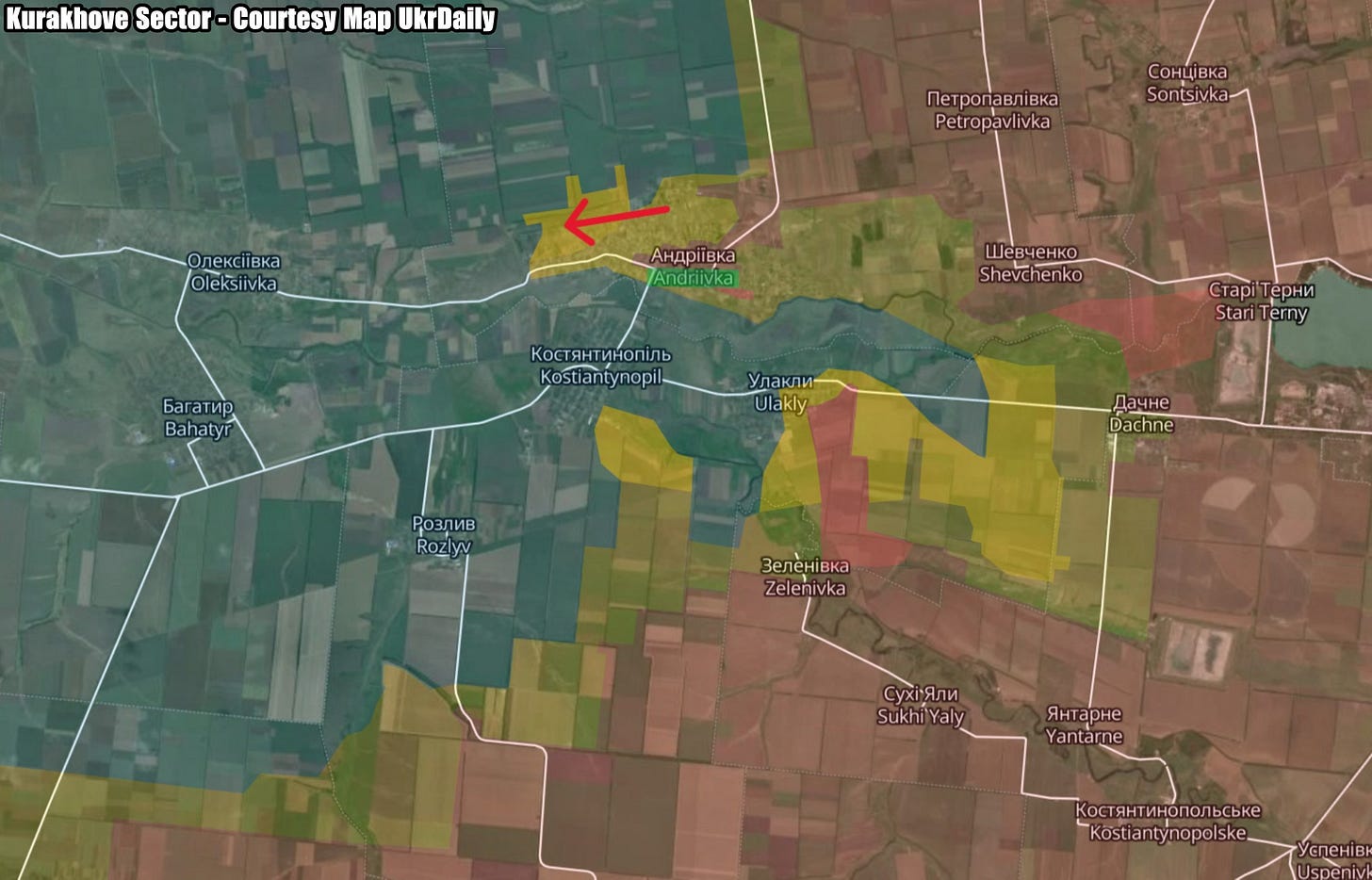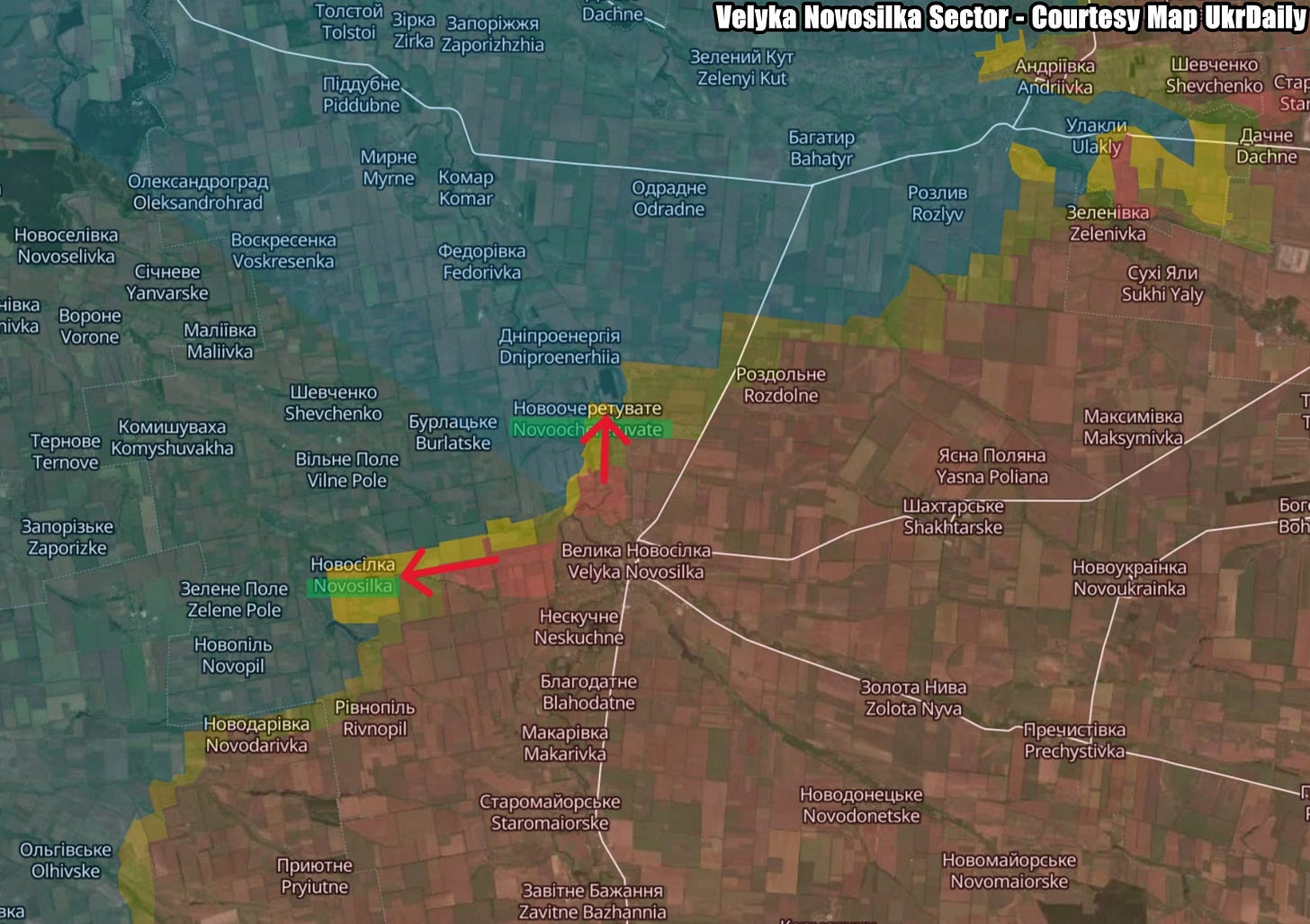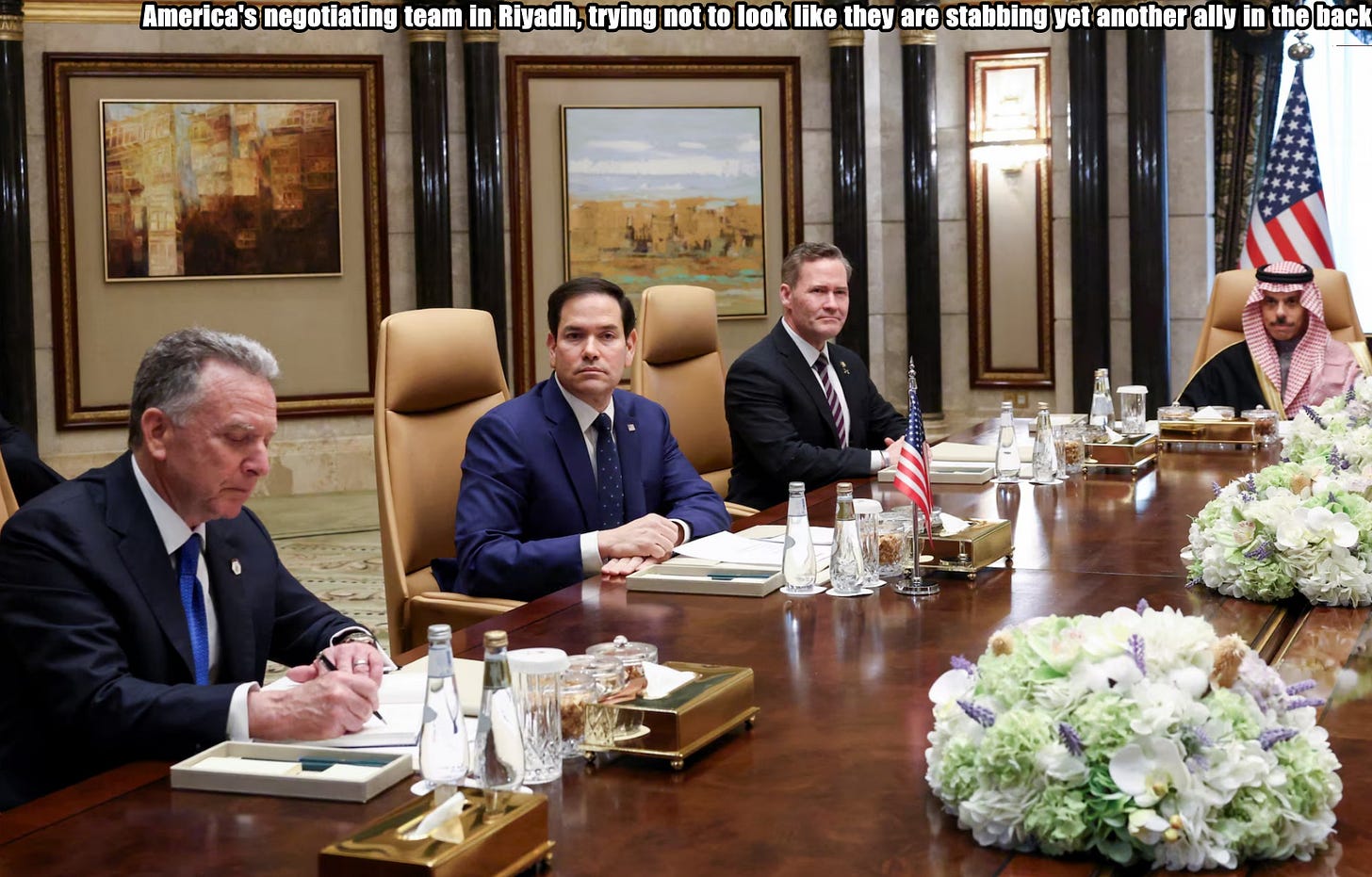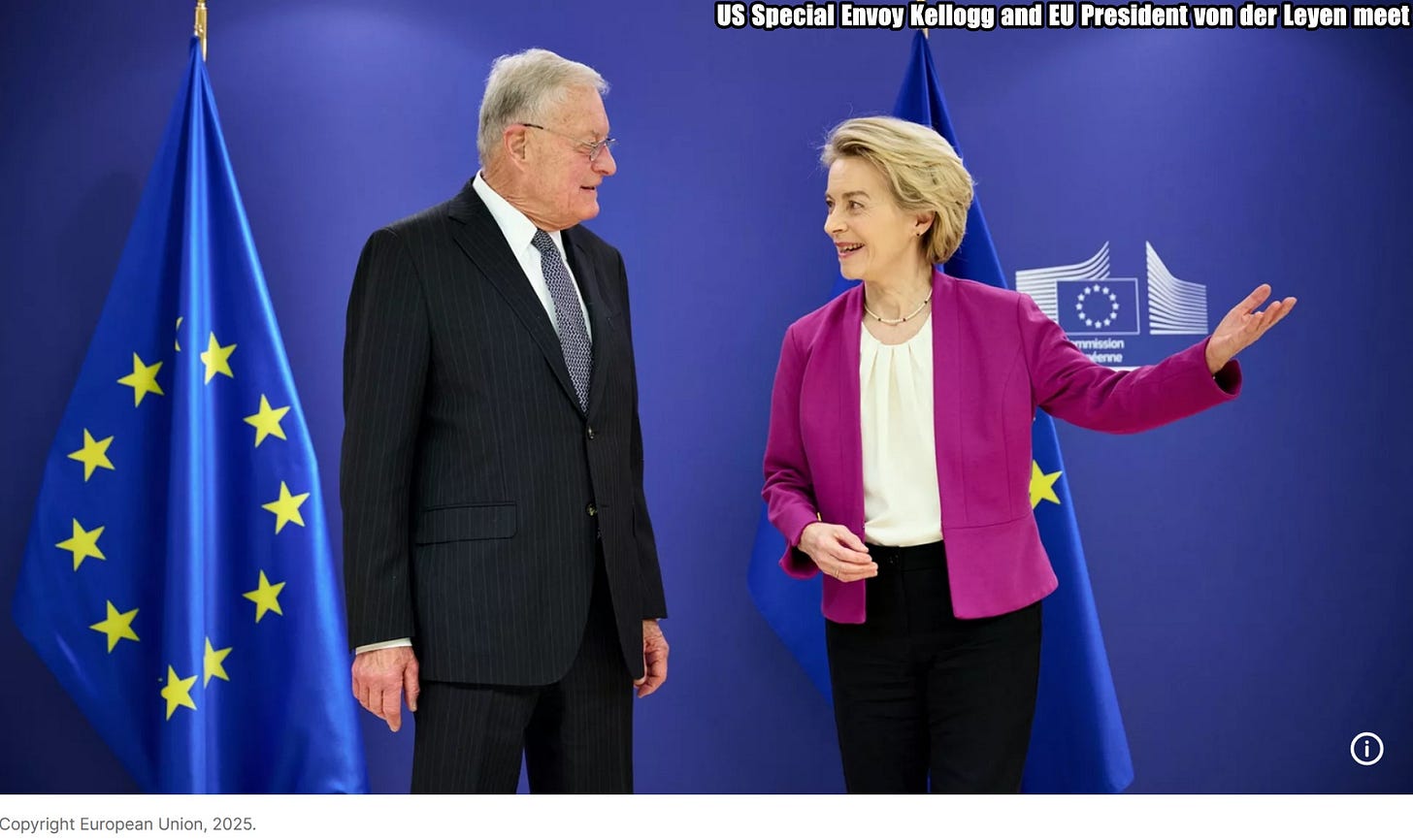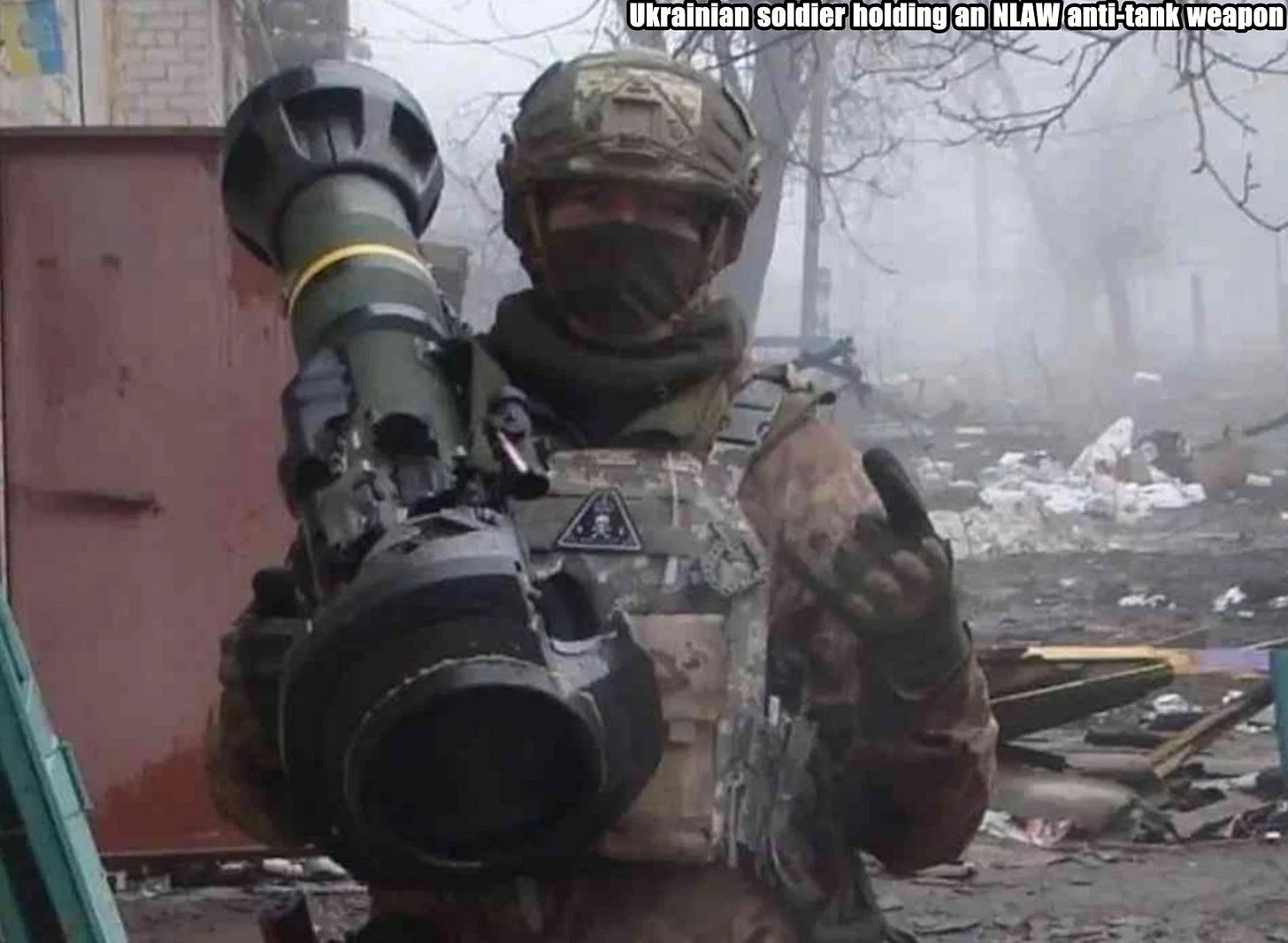Slava Ukraini! In early 2022 I began a Telegram channel aggregating news from a number of sources daily on the war in Ukraine. In June 2023 I began providing a daily draft for the Ukraine War Brief Podcast collecting news from over 70 sources daily, which formed the basis of the script. While the Podcast no longer exists I have continued to make this Brief available for my followers here on Substack for those who wish to keep up with the news from the war.
All the latest news on the Russo-Ukraine War 6 days per week
ALONG THE CONTACT LINE
GSAFU Morning Report
The General Staff of the Armed Forces of Ukraine in its Operational Information update at 08:00 on Feb 18 stated that day 1091 of the full-scale invasion of the Russian Federation against Ukraine had begun.
The situation on the line of combat remains tense in some sectors. Ukrainian defenders continue to actively counteract the Russian aggressor, causing them significant losses in personnel, equipment and technology. Exhausting the enemy along the entire front line and continuing to disrupt the plans of Russian occupiers to advance deeper into the territory of Ukraine.
During the past day, 139 combat engagements took place.
Over the past 24 hours, the enemy carried out 1 missile strike, 71 air strikes, used 2923 drones and fired approximately 5,000 artillery shells across the positions of Ukrainian forces and civilians
Air Force Daily Report
103 ENEMY UAVS SHOT, 67 DROIDS FAILED TO REACH THEIR TARGETS (LOCATIONALLY LOST)
➖➖➖➖➖➖➖➖➖
On the night of Feb 18, 2025 (from 7:00 p.m. on February 17), the enemy attacked with 176 Shahed attack UAVs and simulator drones of various types from six directions: Orel, Bryansk, Kursk, Millerovo, Shatalovo, Primorsko-Akhtarsk - RF, TOT Crimea.
The air attack was repelled by aviation, anti-aircraft missile troops, electronic warfare units, and mobile fire groups of the Air Force and Defense Forces of Ukraine.
As of 09:00, it was confirmed that 103 Shahed attack UAVs and drones of other types were shot down in Kharkiv, Poltava, Sumy, Chernihiv, Cherkasy, Kyiv, Kirovohrad, Vinnytsia, Zhytomyr, Dnipropetrovsk, Kherson and Mykolaiv regions.
67 enemy drones-simulators - lost in location (without negative consequences).
As a result of the enemy attack, the Kirovohrad, Kharkiv, Kyiv, and Cherkasy regions suffered.
Combat Operations in the Kursk Sector, Russian Federation
The Institute for the Study of War (ISW), a US based think tank, in its Feb 17 Russian Offensive Campaign Assessment reported that Russian forces continued offensive operations in the Ukrainian salient in Kursk Oblast on Feb 17 but did not make any confirmed advances. Fighting continued northwest of Sudzha near Nikolsky, west of Sudzha near Sverdlikovo, and south of Sudzha near Kurilovka. A Russian milblogger claimed that Ukrainian forces unsuccessfully counterattacked near Kurilovka.
The Khortytsia operational-strategic group
(Responsible for the northeastern part of Ukraine. )
Toretsk Sector: Russian forces recently advanced in the Toretsk direction. Russian forces continued attacking in Toretsk itself; north of Toretsk near Krymske and west of Toretsk near Shcherbynivka, Novospaske (formerly Petrivka), and Leonidivka on Feb 16 and 17. Russian milbloggers claimed that Ukrainian forces are counterattacking near Shcherbynivka and within Toretsk.
Geolocated footage published on Feb 13 and 15 indicates that Russian forces recently advanced southwest of Leonidivka and along Zhovtneva Street in northern Toretsk, respectively.
The Tavria operational-strategic group
(Responsible for the central-eastern and southeastern part of Ukraine.)
Pokrovsk Sector : Russian forces recently advanced in the Pokrovsk direction. Russian forces continued ground attacks northeast of Pokrovsk near Vodyane Druhe, Tarasivka, and Malynivka; east of Pokrovsk near Myrolyubivka, Yelyzavetivka, and Promin; southeast of Pokrovsk near Lysivka; south of Pokrovsk near Novoukrainka; and southwest of Pokrovsk near Zvirove, Pishchane, Kotlyne, Udachne, Uspenivka, Nadiivka, Yasenove, and Zaporizhzhia on Feb 16 and 17.
Geolocated footage published on February 17 indicates that Russian forces recently advanced on the eastern outskirts of Pishchane.
Kurakhove Sector: Russian forces recently advanced west of Kurakhove. Russian forces continued ground attacks west of Kurakhove near Oleksiivka, Kostyantynopil, Ulakly, Andriivka, and Dachne and southwest of Kurakhove near Zelenivka on Feb 16 and 17 A Ukrainian source reported that Russian forces conducted a roughly battalion-sized mechanized assault near Bahatyr (west of Kurakhove) and Ulakly with 40 armored vehicles and 250 personnel on Feb 15 and lost 39 vehicles - likely in reference to the recent Russian mechanized assault near Ulakly that ISW observed on Feb 16.
Geolocated footage published on February 17 indicates that Russian forces recently advanced in northern Andriivka.
Velyka Novosilka Sector: Russian forces recently advanced in the Velyka Novosilka direction. Russian forces continued assaults north of Velyka Novosilka near Novyi Komar and Novoocheretuvate, northwest of Velyka Novosilka near Burlatske, west of Velyka Novosilka near Novosilka, and southwest of Velyka Novosilka near Rivnopil on Feb 16 and 17. Ukraine's Khortytsia Group of Forces reported on Feb 16 that Ukrainian forces repelled a Russian mechanized assault with "tens" of armored vehicles in several waves near Velyka Novosilka and posted footage showing Ukrainian strikes against at least nine Russian vehicles advancing in a column.
Geolocated footage published on Feb 16 indicates that Russian forces recently advanced to southern Novosilka during a roughly platoon-sized mechanized assault. Additional geolocated footage published on Feb 16 indicates that Russian forces recently advanced southeast of Novoocheretuvate.
The Odesa operational-strategic group
(Responsible for Kherson, Qırım, (also known as Crimea) and the Black Sea.)
There have been no major changes to the combat environment since our last report.
TEMPORARILY OCCUPIED TERRITORIES
Nothing major to report.
THE HOME FRONT
Russian attacks across Ukraine kill 2, injure 26 over past day.
Russian attacks against Ukraine killed two and injured 26 civilians over the past day, the Kyiv Independent reported citing regional authorities on Feb. 18.
Russian forces launched 176 drones from the Russian cities of Orel, Bryansk, Kursk, Shatalovo, Millerovo, Primosk-Akhtarsk, and Russian-occupied Crimea at Ukraine overnight, according to Ukraine's Air Force.
In Donetsk Oblast, one person was killed and another was injured in the city of Pokrovsk, Governor Vadym Filashkin reported.
In the village of Illinivka, one person suffered injuries, while in the town of Kostiantynivka, one civilian, two rescuers, and two police officers were injured.
In Zaporizhzhia Oblast, an 80-year-old man was killed in an artillery attack against the town of Orikhiv. His body was pulled from the rubble, the local military administration reported.
In Kherson Oblast, Russia targeted 32 settlements, including the regional center of Kherson, over the past day. As a result of the attacks, eight people were injured, Governor Oleksandr Prokudin reported.
In Dnipropetrovsk Oblast, Russian forces attacked the Nikopol district with drones and artillery, targeting the Chervonohryhoriv community and the town of Nikopol. The attacks resulted in seven injured civilians, according to Governor Serhii Lysak.
In Kharkiv Oblast, three men, aged 23, 49, and 50, suffered injuries after the Russian strike with an FPV (first-person-view) drone in the village of Kutkivka. Another FPV drone strike injured a 38-year-old man in the village of Prystin, Governor Oleh Syniehubov reported.
In Sumy Oblast, Russia carried out several strikes with FPV drones, injuring one person in the Myropillia community, according to the local military administration.
RUSSIAN WORLD
Kazakh Oil Exports Expected to Drop After Ukrainian Drones Attack Pipeline in Southern Russia.
A Ukrainian drone attack on a major oil pipeline in southern Russia could reduce export volumes by almost a third over the next two months, the Moscow Times reports citing Russia's state pipeline operator on Tuesday.
On Monday, explosive-packed drones hit a pumping station of the Caspian Pipeline Consortium, which carries Kazakh oil across southern Russia for export via the Black Sea, including to western Europe.
"The consequences of this hit will be eliminated within one-and-a-half to two months, which could lead to a fall in the volume of oil pumped from Kazakhstan by 30%," Transneft said in a statement on Tuesday.
The 1,500-kilometre (930-mile) pipeline is owned by a consortium in which the Russian and Kazakh governments, as well as Western energy majors Chevron, ExxonMobil and Shell, hold stakes.
It carries around 80% of Kazakhstan's crude oil exports and about 1% of the total global supply.
Three-quarters of the 63 million tons that flowed through the pipeline last year were pumped by Western energy companies, Transneft said Tuesday.
Asked by AFP how it would redirect oil and what the hit might be to its economy, Kazakhstan's Energy Ministry said it was "currently ascertaining all details on the issue."
Heavily reliant on Russian infrastructure, the Central Asian nation has stepped up efforts to diversify its energy export routes amid the Ukraine war.
Kyiv has targeted Russia's energy infrastructure throughout the three-year conflict, seeking to hit sites it says supply fuel to Moscow's army or provide funds to support its war efforts.
INTERNATIONAL NEWS
Trump’s criminal plan to put Ukraine in a stranglehold.
Donald Trump’s demand for a $500bn (£400bn) “payback” from Ukraine goes far beyond US control over the country’s critical minerals. It covers everything from ports and infrastructure to oil and gas, and the larger resource base of the country.The Telegraph reports.
The terms of the contract that landed at Volodymyr Zelenskyy’s office a week ago amount to the US economic colonisation of Ukraine, in legal perpetuity. It implies a burden of reparations that cannot possibly be achieved. The document has caused consternation and panic in Kyiv.
The Telegraph has obtained a draft of the pre-decisional contract, marked “Privileged & Confidential’ and dated Feb 7 2025. It states that the US and Ukraine should form a joint investment fund to ensure that “hostile parties to the conflict do not benefit from the reconstruction of Ukraine”.
The agreement covers the “economic value associated with resources of Ukraine”, including “mineral resources, oil and gas resources, ports, other infrastructure (as agreed)”, leaving it unclear what else might be encompassed. “This agreement shall be governed by New York law, without regard to conflict of laws principles,” it states.
The US will take 50% of recurring revenues received by Ukraine from extraction of resources, and 50% of the financial value of “all new licences issued to third parties” for the future monetisation of resources. There will be “a lien on such revenues” in favour of the US. “That clause means ‘pay us first, and then feed your children’,” said one source close to the negotiations.
It states that “for all future licences, the US will have a right of first refusal for the purchase of exportable minerals”. Washington will have sovereign immunity and acquire near total control over most of Ukraine’s commodity and resource economy. The fund “shall have the exclusive right to establish the method, selection criteria, terms, and conditions” of all future licences and projects. And so forth, in this vein. It seems to have been written by private lawyers, not the US departments of state or commerce.
President Zelenskyy himself proposed the idea of giving the US a direct stake in Ukraine’s rare earth elements and critical minerals on a visit to Trump Tower in September, hoping to smooth the way for continued arms deliveries.
He calculated that it would lead to US companies setting operations on the ground, creating a political tripwire that would deter Vladimir Putin from attacking again.
Some mineral basins are near the front line in eastern Ukraine, or in Russian-occupied areas. He has played up the dangers of letting strategic reserves of titanium, tungsten, uranium, graphite and rare earths fall into Russian hands. “If we are talking about a deal, then let’s do a deal, we are only for it,” he said.
Republican Senator Lindsey Graham suggested at the Munich Security Conference over the weekend that Trump’s demand was a clever ploy to bolster declining popular support for the Ukrainian cause. “He can go to the American people and say, ‘Ukraine is not a burden, it is a benefit,’” he said.
Sen Graham told the Europeans to root hard for the idea because it locks Washington into defending a future settlement. “If we sign this minerals agreement, Putin is screwed, because Trump will defend the deal,” he said.
Ukrainian officials had to tiptoe through this minefield at the Munich forum, trying to smile gamely and talking up hopes of a resource deal while at the same pleading that the current text breaches Ukrainian law and needs redrafting.
Russia and US agree at talks without Ukraine to press ahead with bid to end war.
The United States and Russia agreed in Riyadh on Tuesday to press ahead with efforts to end the war in Ukraine, a U.S. official said, as Kyiv and its European allies watched anxiously from the sidelines and Moscow raised a major new demand. Reuters reports.
U.S. State Department spokesperson Tammy Bruce said the two sides agreed to appoint "respective high-level teams to begin working on a path to ending the conflict in Ukraine as soon as possible in a way that is enduring, sustainable, and acceptable to all sides".
Russian negotiator Yuri Ushakov told reporters after more than four hours of talks: "It was a very serious conversation on all the questions we wanted to touch upon."
Ukraine and European leaders are worried that President Donald Trump could cut a hasty deal with Russian President Vladimir Putin that ignores their security interests, rewards Moscow for its invasion and leaves Putin free to threaten Ukraine or other countries in the future.
Even while the meeting in the Saudi capital was under way, Russia signalled a hardening of its demands.
Foreign Ministry spokeswoman Maria Zakharova told reporters in Moscow it was "not enough" for NATO not to admit Ukraine as a member. She said the alliance must go further by disavowing a promise it made at a summit in Bucharest in 2008 that Kyiv would join at a future, unspecified date.
"Otherwise, this problem will continue to poison the atmosphere on the European continent," she said. There was no immediate response from Ukraine, NATO members or the United States.
Ukrainian President Volodymyr Zelenskyy has consistently demanded NATO membership as the only way to guarantee Kyiv's sovereignty and independence from its nuclear-armed neighbour.
U.S. spokesperson Bruce said in a statement: "President Trump wants to stop the killing; the United States wants peace and is using its strength in the world to bring countries together. President Trump is the only leader in the world who can get Ukraine and Russia to agree to that."
She said the two sides had also agreed to consult in order to address "irritants" in their bilateral relations, which the Kremlin described as "below zero" during the previous U.S. administration of Joe Biden.
Ushakov was quoted by Interfax news agency as saying conditions were discussed for a meeting between Trump and Putin, although he said it was unlikely to happen next week.
The talks in Saudi Arabia, which has friendly ties with both countries, underscored the rapid pace of U.S. efforts to halt the war, less than a month after Trump took office and six days after he spoke by phone to Putin.
Critics say that Trump's team, by ruling out NATO membership for Ukraine and saying that Kyiv's desire to win back all its lost territory is an illusion, has made major concessions in advance. U.S. officials say they are simply recognising reality.
Ukraine says no peace deal can be done on its behalf. "We, as a sovereign country, simply will not be able to accept any agreements without us," Zelenskiy said last week.
Europe's seat at the table still uncertain after diplomatic flurry.
Ursula von der Leyen and António Costa have met with Keith Kellogg, the US special envoy for Russia and Ukraine, who has made it clear that Europe would be excluded from the negotiating table. Euro News reports.
Europe's seat at the negotiating table to end Russia's war on Ukraine remains shrouded in deep uncertainty after a flurry of diplomatic encounters.
Keith Kellogg, the US Special Envoy for Ukraine and Russia, met separately on Tuesday with Ursula von der Leyen, president of the European Commission, and António Costa, the president of the European Council, both of whom are keen to reassert the bloc's position in the rapidly moving process promoted by Donald Trump.
The outcome of the meetings suggests neither president has obtained additional reassurances that a seat would be reserved for Europe.
However, US Secretary of State Marco Rubio, speaking from Saudi Arabia after the first round of talks with his Russian counterpart, said the EU would be asked to join the table but only to grant sanctions relief for the Kremlin.
The meetings with Kellogg come a day after a group of eleven European leaders, including von der Leyen and Costa, gathered in Paris for an emergency meeting convened by French President Emmanuel Macron in reaction to the phone call between Donald Trump and Vladimir Putin and the sudden start of negotiations.
Macron spoke with Trump before and after the summit.
The French leader also spoke with Ukrainian President Volodymyr Zelenskyy, who has repeatedly warned his country would not accept a deal made behind its back.
The Trump-Putin call, which took place without prior consultation with Western allies, broke the three-year-long effort to isolate the Russian leader diplomatically and sent powerful shockwaves across European capitals, leaving them visibly rattled.
The Kremlin said the encounter had been a "serious conversation on all issues" but that it was "difficult" to assess whether positions were "converging."
Secretary Rubio called it "the first step of a long and difficult journey," with more meetings to follow. "The goal is to bring an end to this conflict in a way that's fair, enduring, sustainable and acceptable to all parties involved," Rubio said.
No date has yet been set for a meeting between Trump and Putin.
MILITARY & TECH
Expert dismisses claims of Ukraine wasting Western arms.
According to the report, Ukrainian forces have been employing Soviet-style tactics that allegedly waste expensive NATO-supplied weaponry, prompting concerns about battlefield efficiency. Defence Blog reports.
The article claims that Ukrainian troops are using Next-generation Light Anti-Tank Weapons (NLAWs), priced at approximately £20,000 per unit, in the same manner as inexpensive rocket-propelled grenades (RPGs). It states that instead of deploying them with precision as per NATO doctrine, Ukrainian forces have been launching costly salvos exceeding £100,000 in value. Additionally, the report alleges that Ukrainian troops have abandoned Javelin missile launchers on the battlefield, some of which have purportedly fallen into Russian hands.
However, the validity of these claims has been challenged by defense experts, including military analyst Nicholas Drummond, who dismissed the accusations as baseless propaganda aimed at undermining Ukraine’s war effort.
“This is utter nonsense. It’s clearly Russia trying to create a plausible narrative to discredit Ukraine, divide NATO, and help secure a peace deal that favours Putin’s agenda. In fact, you’ve got to admire how good at this kind of information warfare Russia has become.,” Drummond wrote in response to the claims.
The debate over Ukraine’s battlefield tactics reflects a broader discussion about the applicability of NATO-style warfare in a conflict of this scale and intensity. Unlike previous Western engagements in Afghanistan, Iraq, or the Balkans—where NATO forces faced relatively weaker or outdated military opponents—Ukraine is confronting a technologically advanced Russian military with a numerical advantage and extensive resources.
Traditional NATO doctrines emphasize precision strikes, logistical superiority, and combined arms maneuvers. However, experts note that these strategies were developed for engagements where the West held overwhelming air superiority, well-coordinated supply chains, and a secure rear. In contrast, Ukraine’s war has taken on characteristics reminiscent of large-scale 20th-century conflicts, with extensive trench warfare, massed artillery barrages, and high-intensity drone warfare playing a critical role in shaping the battlefield.
The intensity of combat in Ukraine also mirrors historical large-scale conflicts, where overwhelming firepower and attritional warfare have determined outcomes. Unlike NATO’s counterinsurgency campaigns against lightly equipped forces such as the Taliban or Saddam Hussein’s army, Ukraine is waging a full-scale war against a peer adversary equipped with advanced missile systems, electronic warfare capabilities, and a vast reserve of manpower.
Military analysts emphasize that Ukraine’s strategic choices are dictated by necessity rather than doctrine. Faced with constraints in manpower and resources, Ukrainian forces have had to adapt their tactics in real time to counter Russian advancements. The rise of drone warfare, the mass deployment of first-person view (FPV) drones, and the integration of loitering munitions highlight how Ukraine has rapidly innovated despite operating at a disadvantage.
“Ukraine isn’t just fighting a war—it’s redefining modern warfare,” one analyst noted. “The Western idea of conventional warfare doesn’t fully apply here. We’re seeing a fusion of large-scale mechanized combat, digital battlefield awareness, and drone technology like never before.”
While NATO countries have provided military support, no Western nation has faced the sheer scale and intensity of combat Ukraine is experiencing. Critics argue that it is unrealistic to expect Ukraine to fully adhere to NATO’s peacetime training doctrine in a war where survival hinges on rapid adaptation and unconventional solutions.
The claims made in The Telegraph align with previous Russian narratives aimed at undermining Ukraine’s credibility among its Western allies. Moscow has frequently sought to exploit divisions within NATO and discredit Ukraine’s military strategies to weaken international support. Disinformation campaigns have been a cornerstone of Russian hybrid warfare, leveraging Western media outlets to amplify misleading narratives that paint Ukraine as reckless or untrustworthy.
At a time when Ukraine continues to push for increased military assistance, particularly in advanced air defense systems and long-range missile capabilities, reports that cast doubt on its operational effectiveness risk playing into Russian objectives.
While questions about battlefield tactics and efficiency are natural in any prolonged war, broad accusations that Ukraine is recklessly wasting NATO weaponry do not align with the strategic realities on the ground. Ukraine’s ability to hold back and, in some cases, push back a vastly superior force demonstrates tactical ingenuity rather than carelessness.
That’s it for today’s Brief folks if you would like to keep up with events in Ukraine daily please consider subscribing, it’s free!


